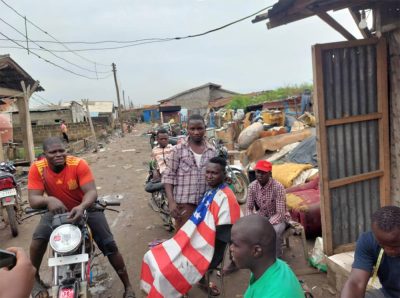Lagos, City of Migrants
From its origins as a fishing village in the 1600s, Lagos has urbanised stealthily into a vast metropolis, wielding extensive economic, political and cultural influence on Nigeria and beyond. Migration in search of opportunities has been the major factor responsible for the demographic and spatial growth of the city as Lagos has grown from 60,221 in 1872 to over 23 million people today. The expansion of the city also comes with tensions around indigene-settler dynamics, especially in accessing land, political influence and urban resources. There are also categories of migrants whose status determines if they can lay hold of the “urban advantage” that relocating to a large city offers.
A major impetus to the evolution of modern Lagos is the migration of diverse groups of people from Nigeria’s hinterland and beyond. By the 1800s, waves of migrants (freed slaves) from Brazil and Freetown had made their way to Lagos, while many from Nigeria’s hinterland including the Ekiti, Nupes, Egbas and Ijebus began to settle in ethnic enclaves across the city. In the 1900s, migrant enclaves were based on socio-economic and/or ethnicity status. Hausas (including returnees from the Burma war) settled in Obalende and Agege, while the Ijaw and Itsekiri settled in waterfront communities around Ajegunle and Ijora. International migrant communities include the Togolese, Beninoise and Ghanaian, as well as large communities of Lebanese and Indian migrants. The names and socio-cultural mix in most Lagos communities derive from these historical migrant trajectories.
Permanent temporalities
A study on coordinated migrations found that, as a destination city, Lagos grew 18.6 per cent between 2000 and 2012, with about 96 per cent of the migrants coming from within Nigeria. While migration to Lagos has traditionally been in search of economic opportunities, new classes of migrants have emerged over the last few decades. These are itinerant migrants and internally displaced persons.
Itinerant migrants are those from other areas of Nigeria and West Africa who travel to work in Lagos while keeping their families back home. Mobility cycles can be weekly, monthly or seasonal. Such migrants have no address in Lagos as they often sleep at their work premises or in mosques, saving all their earned income for remittance. They include construction artisans from Benin and Togo who come to Lagos only when they have jobs, farmers from Nigeria’s northern states who come to Lagos to work as casual labourers in between farming seasons (see box), as well as junior staff in government and corporate offices whose income is simply too small to cover the high cost of living in Lagos.
While people from Nigeria’s hinterland continue to arrive in the city in droves, the wave of West African in-migration has ebbed significantly. This is mostly because of the economic challenges Nigeria is currently facing that have crashed the Naira-to-CFA exchange rates. As a result, young men from Togo, Ghana and Benin are finding cities like Dakar and Banjul more attractive than Lagos.
 Aliu* aka Mr Bushman, from Sokoto, Age 28Aliu came to Lagos in 2009 on the back of a cattle truck. His first job was in the market carrying goods for market patrons. He slept in the neighbourhood mosque with other young boys. Over the years, he has done a number of odd jobs including construction work. In 2014, he started to work as a commercial motorcyclist (okada) and later got the opportunity to learn how to repair them. He calls himself an engineer and for the past four years has earned his income exclusively from riding and repairing okada. Even though he can afford to rent a room, he currently lives in a shared shack with seven other migrants. He makes between N5000 and N8000 weekly and sends most of it to his family through a local transport operator who goes to Sokoto weekly. His wife and three children are in the village, but he would rather send them money than bring them to Lagos. According to him, “The life in Lagos is too hard for women”. Since he came to Lagos thirteen years ago, Aliu has never spent more than four months away from Sokoto at a time. He stays in Sokoto during the rainy season to farm rice, maize and guinea corn, and has travelled back home to vote every time since he came to Lagos. |
The second category of migrants are those who have been displaced from their homesteads in Northern Nigeria by conflict, either Boko Haram insurgency or invasions by Fulani herdsmen. The crises have resulted in the violent destruction of many communities, with hundreds of thousands killed and many more forced to flee. With many who initially settled in camps for Internally Displaced Persons (IDP) dissatisfied with camp conditions, the burden of protracted displacement is now spurring a new wave of IDP migration to urban areas. Even though empirical data on the exact number of displaced persons migrating out of camps to cities is difficult to ascertain, it is obvious that this category of migrants are negotiating their access to the city and its resources in circumstances quite different from those of other categories of migrants.
IDPs as the emerging migrant class in Lagos
According to the United Nations High Commission for Refugees, two of every three internally displaced persons globally are now living in cities. Evidence from Nigeria suggests that many IDPs are migrating to urban areas in search of relative safety and resettlement opportunities, with Lagos estimated to host the highest number of independent IDP migrants in the country. In moving to Lagos, IDPs are shaping the city in a number of ways including appropriating public spaces and accelerating the formation of new settlements.
There are three government-supported IDP camps in the city, with anecdotal evidence pointing to about eighteen informal IDP shack communities across the city’s peri-urban axis. This correlates with studies from other cities that highlight how this category of habitations (as initial shelter solutions for self-settled IDPs) accelerate the formation of new urban informal settlements and spatial agglomerations of poverty and vulnerability.
While people from Nigeria’s hinterland continue to arrive in the city in droves, the wave of West African in-migration has ebbed significantly.
IDPs in Lagos move around a lot. Adamu, who currently lives in Owode Mango—a shack community near the Lagos Free Trade zone—and has been a victim of forced eviction four times said, “As they [government or land owners] get ready to demolish this place and render us homeless again, we will move to another area and live there until they catch up with us.”
In the last ten years, there has been an increase in the number of homeless people on the streets of Lagos—either living under bridges, in public parks or incomplete buildings. Many of them are IDPs who are new migrants, and unable to access the support necessary to ease their entry into the city’s established slums or government IDP camps. Marcus, who came from Adamawa State in 2017 and has been living under the Obalende Bridge for five years, said, “I am still managing, living under the bridge. I won’t do this forever, my life will not end like this under a bridge. I hope to one day return to my home and continue my life”.
Blending in or not: Urban integration strategies
Urban integration can be a real challenge for IDP migrants. Whereas voluntary migrants are often perceived to be legal entrants to the city and so can lay claim to urban resources, the same cannot be said about IDPs. Despite being citizens, and despite Nigeria being a federation, IDPs do not have the same rights as other citizens in many Nigerian cities and constantly face stigmatisation and harassment, which reinforces their penchant for enclaving.
The lack of appropriate documentation and skillsets also denies migrants full entry into the socio-economic system. For example, Rebekah said: “I had my WAEC [Senior Secondary school leaving certificate] results and when Boko Haram burnt our village, our family lost everything including my certificates. But how can I continue my education when I have not been able to get it? I have to do handwork [informal labour] now”. IDP children make up a significant proportion of out-of-school children in Lagos as many are unable to get registered in school simply because of a lack of address.
Most IDPs survive by deploying social capital—especially ethnic and religious ties. IDP ethnic groupings are quite organized; most belong to an ethnic-affiliated group and consider this as particularly beneficial to their resettlement and sense of identity in Lagos. Adamu from Chibok said, “When I come to Lagos in 2017, I come straight to Eleko. My brother [kinsman] help me with house, and he buy food for my family. As I no get work, he teach me okada work wey he dey do.”
The crises have resulted in the violent destruction of many communities, with hundreds of thousands killed and many more forced to flee.
Interestingly, migration to the city can also be good for women as many who were hitherto unemployed due to cultural barriers are now able to work. Mary who fled Benue with her family due to farmer-herder clashes explained, “When we were at home [in Benue], I was assisting my husband with farming, but here in Lagos, I have my own small shop where I sell food. Now I have my own money and my own work.”
Need for targeted interventions for vulnerable Lagosians
“Survival of the fittest” is an everyday maxim in the city of Lagos. For migrants, this is especially true as they are not entitled to any form of structured support from the government. Self-settlement is therefore daunting, especially in light of systemic limiting factors.
Migrants are attracted to big cities based on perceived economic opportunities, and with limited integration, their survival strategies are inevitably changing the spatial configurations of Lagos. While the city government is actively promoting urban renewal, IDP enclaving is creating new slums. Therefore, addressing the contextualised needs of urban migrant groups is a sine qua non for inclusive and sustainable urban development.
“I am still managing, living under the bridge. I won’t do this forever, my life will not end like this under a bridge. I hope to one day return to my home and continue my life”.
There is an established protocol for supporting international refugees. However, the same cannot be said for IDPs who are Nigerian citizens. They do not enjoy structured support outside of camps, and we have seen that camps are not an effective long-term solution to displacement. There is a high rate of IDP mobility to cities like Lagos, which establishes the fact that cities are an integral part of the future of humanitarian crisis. Their current survival strategies are not necessarily harnessing the urban advantage, especially due to lack of official recognition and documentation. It is therefore imperative that humanitarian frameworks take into account the role of cities and also the peculiarities of IDP migrations to them.
Lagos remains a choice destination city and there is therefore need to pay more attention to understanding the patterns, processes and implications of migration into the city. The paucity of migration-related empirical data no doubt inhibits effective planning for economic and social development. Availability of disaggregated migration data will assist the state to develop targeted interventions for the various categories of vulnerable Lagosians. Furthermore, targeted support for migrant groups must leverage existing social networks, especially the organised ethnic and religious groups that migrants lean on for entry into the city and for urban integration.
–
*All names used in this article are pseudonyms
This article is part of a series on migration and displacement in and from Africa, co-produced by the Elephant and the Heinrich Boll Foundation’s African Migration Hub, which is housed at its new Horn of Africa Office in Nairobi.





